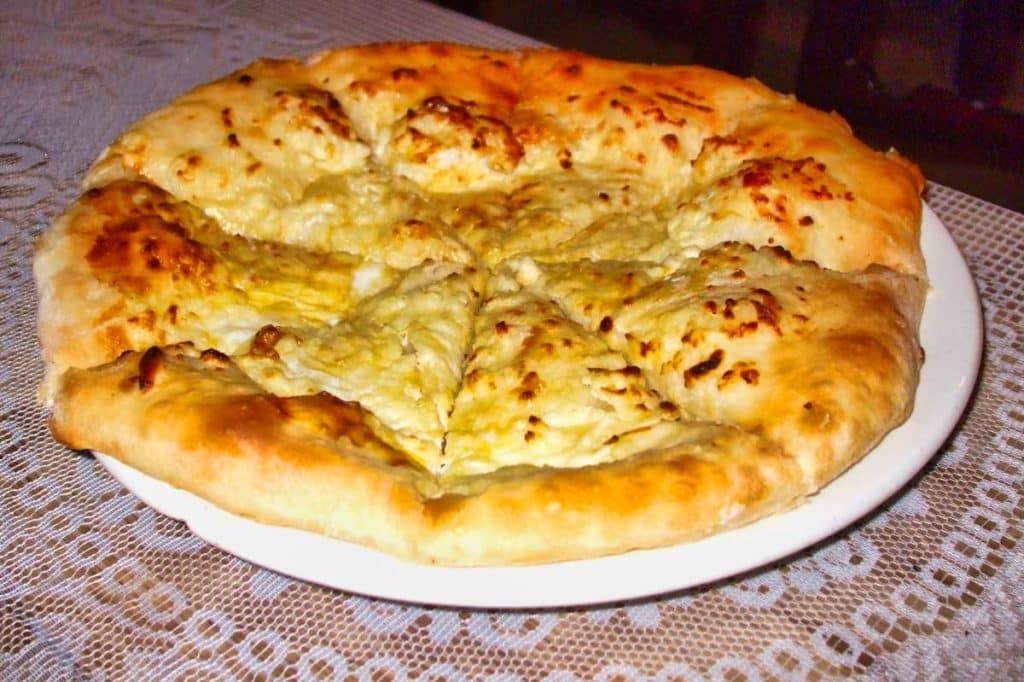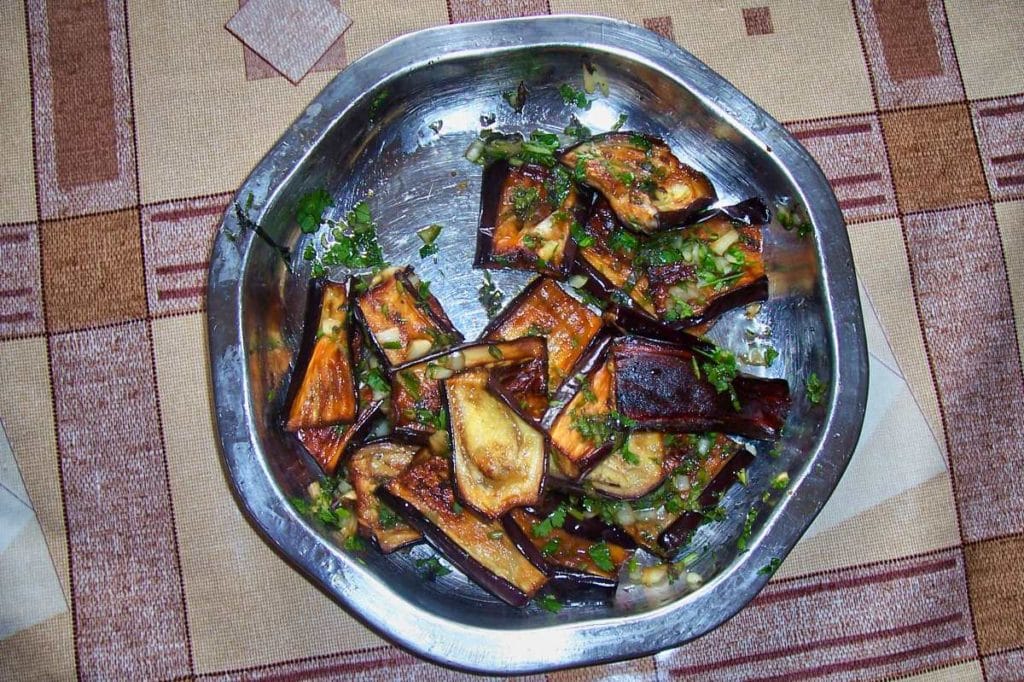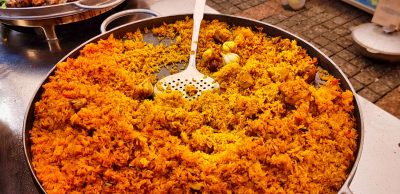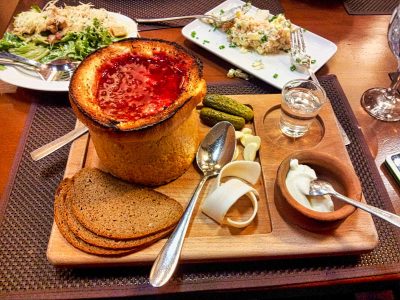At the time of the Cold War, Georgian cuisine was considered the “haute cuisine of the Soviet Union”. Tasting the numerous culinary delights of the country, one comes to the conclusion that this title is absolutely justified. Georgian food is distinguished above all by its high quality and versatility. In addition, the different regions have their own specialties on the table, which are characteristic for them. A variety of meats, fruits and vegetables, as well as the use of walnuts in many dishes, ensure that Georgian food is extremely varied. Georgian food, by the way, is also something for vegetarians and vegans.
Food plays a major role in Georgian culture. People often eat together in larger groups. This special form of feast, where the whole table is full of delicacies, is called “supra” in Georgia and follows special rites. Among other things, a table master (tamada) is always appointed to direct the proceedings at the table and to propose toasts. But enough of the preface, here is our Top 10 of the best dishes of Georgian cuisine!

Khachapuri
One of the most popular dishes in Georgia is undoubtedly Khachapuri. Basically, it is a yeast dough topped with cheese and then baked in the oven. The bread is traditionally eaten with the hands – and very warm. When you bite into it, the cheese is supposed to pull really nice strings. In Georgia, there are many different regional varieties of the bread, which is eaten with pleasure on every occasion. However, the most popular forms of khachapuri are served in most restaurants throughout the country.
Local variants
Among them is Imeruli Khachapuri from the region of Imeretia in the heart of the country. Imeruli Khachapuri has a circular shape, similar to a pizza, and is usually filled with the cheese “sulguni”. An even richer version of the dish, which is not really low in calories anyway, is the Ajarian version from the west of the country. Here the bread is shaped like a boat, filled with cheese in the middle. Finally, it is topped with an egg and butter. This version is also the one most often found in Georgian restaurants in the west.

Khinkali
Also eaten by hand is another specialty from Georgia: Khinkali. These filled dumplings, which originally come from the high mountains in Mtskheta-Mtianeti in the east of the country, look like little bags that have been tied up. The many folds on the dough are supposed to symbolize the sun and its rays. These delicacies are traditionally filled with minced meat, which is seasoned with salt, pepper, garlic and onions, and often also with coriander, parsley or cumin. In vegetarian versions, the meat can be replaced by mushrooms, cottage cheese or potatoes.
It’s all about the right technique!
When eating you should pay attention to a special technique: The dumpling is bitten open on the stalk, which is slightly cooler than the rest. Then you suck the juice from the chinkali and eat the rest. The tip of the dough is usually not eaten, but placed on the edge of the plate.
Lobiani
Lobiani is a bean-filled bread that, like Khachapuri, is one of the most important national pastries in Georgia. Traditionally, Lobiani is baked on the church holiday “Barbaroba”, the name day of St. Barbara. But also during the rest of the year the bean pastry is one of the most popular and tasty dishes in Georgia. As with Khachapuri, there are several variations of the bread. In the “normal” Lobiani, a spiced bean paste is baked in a yeast dough. In addition, there are other forms in which, for example, the yeast dough is replaced by puff pastry or in which bacon is added in addition to the beans.
A snack for Lenten season
For people who follow the rules of the Georgian Orthodox Church, Lobiani has great significance, especially during Lent. Since they are not allowed to consume animal products during this period, the bean-filled bread is a good and especially vegan alternative to Khachapuri.

Badrijani
This popular appetizer is also meatless. Badrijani consist of fried eggplants filled with a walnut paste and then rolled up. The very finely ground walnuts are seasoned with garlic and saffron. The eggplant rolls are traditionally garnished with pomegranate seeds and herbs. This delicious appetizer is available in almost every Georgian restaurant. It is often served with bread.

Mtsvadi
Georgians also like to barbecue: one particularly popular dish is Mtsvadi, which is considered the original form of Shashlik. The meat skewer originally comes from the Kakheti region in the east of the country. Whether at market stalls, picnics in the countryside or in restaurants, there are many places where you can try the delicious skewers.
In traditional preparation, the meat is first cut into pieces and then marinated for up to 12 hours in a marinade of salt, pepper, strong red wine, onions, a little oil and some herbs. The pieces are then skewered on particularly wide blades. Mtsvadi are not grilled over charcoal, but directly over wood, which gives them a smoky flavor. Both sheep, chicken, veal and pork are used.
Satsivi
Another classic dish of Georgian cuisine is Satsivi, which is especially popular around poultry meat such as chicken, turkey or turkey is dipped in a creamy and spicy walnut sauce. This is traditionally made from water, garlic, a combination of various dried herbs, vinegar, pepper and salt, in addition to walnuts. However, many different recipes circulate in the country, so the preparation may well differ regionally. “Tsivi”, by the way, means “cold” in Georgian – so the name of the dish also refers to how the food is served. Satsivi is a cold snack. In vegetarian versions, the poultry is replaced by eggplant or cauliflower.
Chakhokhbili
Chakhokhbili is a tasty stew consisting of chicken, tomatoes and fresh herbs. The name is derived from the Georgian term “Khokhobi”, which means “pheasant”. In fact, originally people used pheasant meat for the stew, not chicken. Chakhokhbili is also very popular in Georgia because it is relatively uncomplicated to prepare and the ingredients are quite affordable – at least if you rely on chicken meat and do not use pheasants ….
Chanakhi
Another delicious stew is Chanakhi. This specialty consists of lamb, potatoes, eggplant, peppers, tomatoes and herbs. Compared to Chakhokhbili, the preparation is a bit more time-consuming – but the result should speak for itself in the end. A special feature of Chanakhi is that the stew is traditionally cooked for several hours in a closed clay pot at a low temperature. This ensures that the meat is butter-tender when served. Instead of a clay pot, however, you can also use a slow cooker to prepare the stew.

Churchkhela
Georgian cuisine, of course, has some delicious desserts too: This sweet delicacy is also called the “Georgian Snickers”. Everywhere in the country you can buy and try Churchkhela at stalls. The name for the specialty translates as “sausage made of walnuts” – a name that already describes this dish very well. During preparation, nuts are strung on a thread and then covered several times with a grape juice coating. Then they are dried in the warm air for two weeks. After this time, the finished product can be bent like rubber without breaking. Stored in a dry place, the Churchkhela can be kept for months.

Georgian Drinks: Wine and Chacha
Those who believe that in the past only vodka and Crimean sparkling wine was drunk in the Soviet Union are mistaken. Georgia is historically considered one of the countries where viticulture first took place, and the climatic conditions here are ideal. Wine is also the country’s second most important export. There are many white wine varieties, but the country is best known for its often sweet red wines. A special feature are the quevri, clay vessels for aging the wine. This wine storage method has even been declared a World Heritage Site by UNESCO.
After a rich Georgian meal, perhaps the high-proof Chacha will help with digestion. This is a pomace brandy that is usually drunk neat and is best served ice cold. The name for this “Grappa of the Caucasus” is derived from the Georgian word for marc. Chacha is to be enjoyed with caution, however, as the alcohol content of the schnapps can vary. While “softer” variants have a value of 40 to 45 percent, there are also distilleries that offer their Chacha with an alcohol content of more than 60 percent. In Georgia, the schnapps is not only produced industrially, but many families have a tradition of distilling it themselves.
Georgian Food: Our Book Recommendations
You wanted to bring Georgian cuisine to your home and cook Georgian food yourself? No problem, our cookbook tips will help!
No products found.
Not a classic cookbook, but a journey through the country that presents many recipes along it’s way
No products found.
This book dares to take a slightly different approach and treats the Caucasus as a whole. So it takes a look not only at Georgian cuisine, but also at the delicacies of Azerbaijani cuisine, which we’ve introduced to you here before.
No products found.
This book focuses solely on Georgia, but well, there is enough to discover here! 111 recipes, well sorted by courses, will make your mouth water.
How did you like our article about Georgian cuisine? Have you ever tried Georgian food and what are your favorite Georgian dishes? Let us know and write us a comment! Feel free to follow Wildeast on Facebook or Pinterest to stay up to date with the latest articles. And if you click here, you will be taken directly to an overview of other regional cuisines of Eastern Europe that we have already presented to you.



